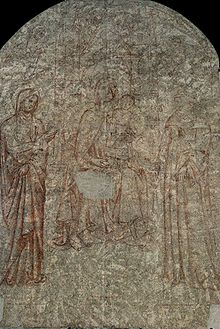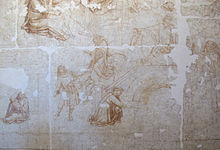- 作者: (英國)菲利普·鮑爾
- 出版社:譯林出版社
- 出版日期:2018/03/01
- 語言:簡體中文
這部書用科學和藝術的精工去繪製金碧山水,從而創造一套色彩的語言,幫助眼睛重新觀看色彩的繪畫和色彩的世界。——范景中
這部作品是對西方繪畫的一次全新審視,敘述簡潔,構思精巧。在學術史與一系列可讀性極強的奇聞趣事和藝術家傳略之間,鮑爾恰如其分地揮灑著他的淵博才學。——《每日郵報》
一部研精究微、信息量極大的色彩大全。——《泰晤士報文學副刊》
充滿了妙趣橫生的小插曲……鮑爾動人地書寫了諸多複雜的主題。——《星期日電訊報》
內容簡介
作者:(英國)菲利普·鮑爾,譯者:何本國。菲利普·鮑爾(Philip Ball),英國科學與科普作家,《自然》期刊特約顧問編輯。他在牛津大學主修化學,后來又在布里斯托爾大學獲得物理學博士學位,所著的社會物理學著作《預知社會——群體行為的內在法則》(2004)獲英國安萬特科學圖書大獎,另外還著有《牛津通識讀本:分子》(2003)、《為帝國服務:希特勒時期為物理學真諦而戰》(2014)、《圖案密碼:大自然的藝術與科學》(2016)等多部作品。
----
《明亮的泥土》:從文藝復興到克萊因藍,顏料如何左右藝術
在《明亮的泥土》一書中,他書寫了一部顏料的發明史,在這個過程中,顏色的創新毋庸置疑地影響了藝術家的表達。
中世紀的顏料技術創新,使威尼斯畫派點亮了文藝復興的榮光;
17世紀巴洛克時期簡樸調色板的復興,使用有限的顏料如何表達藝術;
19世紀化學工業的合成色料創新,造就了印象派的明亮效應;
作為現代化學的產物,新顏料以技術啟發了藝術,拓展了藝術的邊界。
在本書的封底,鮑爾不無動情地說,顏色是時代之選,每個藝術家,都與他所處時代的顏色有一份獨特的約定。
原文網址:https://kknews.cc/culture/oqo8rjp.html
圖書目錄
編輯第一章 注視者的目光——畫室裏的科學家
第二章 擷取彩虹——關於顏色的物理學和化學
第三章 火神的熔爐——古代的顏料技術
第四章 秘方——鍊金術的藝術遺產
第五章 光影大師——文藝復興的榮光
第六章 古老的黃金——簡樸調色板的復興
第七章 多彩的金屬——合成色料與顏色化學的黎明
第八章 光的統治——印象派的明亮效應
第九章 對紫色的激情——染料,以及顏料的工業化
第十章 午夜暗影——關於藍色
第十一章 時間這個畫家——不停變化的畫布
第十二章 捕捉顏色——藝術如何在複製中顯現
第十三章 心勝於物——在現代主義中作為形式的顏色
第十四章 純粹的藝術——新的材料,新的視野
註釋
參考書目
索引 [1]
在解釋古代關於顏色在藝術中的應用的著作是,很可能混淆紅色和綠色。中世紀的sinople 來自普林尼的sinopis ,再往前可以從地理學方面追溯到一種來自黑海邊的錫諾普Sinope的紅色土質色料。至少在15世紀前,sinople 既可以指紅色也可以指綠色。(查看原文)
Sinople may refer to:
- Sinopia, or sinople, a dark reddish earth pigment
- Sinople (heraldry), a term for "red", and later "green" in heraldry
- Plovdiv, Bulgaria, a city called “Sinople” by the Crusaders
Sinopia (also known as sinoper, named after the now Turkish city Sinop) is a dark reddish-brown natural earth pigment, whose reddish colour comes from hematite, a dehydrated form of iron oxide. It was widely used in Classical Antiquity and the Middle Ages for painting, and during the Renaissance it was often used on the rough initial layer of plaster for the underdrawing for a fresco. The word came to be used both for the pigment and for the preparatory drawing itself, which may be revealed when a fresco is stripped from its wall for transfer.
During the Middle Ages sinopia in Latin and Italian came to mean simply a red ochre. It entered the English language as the word sinoper, meaning a red earth colour.[1]
Sinopia is a colour in various modern colour systems.



Bright Earth: Art and the Invention of Color Tapa blanda – 15 Abril 2003
de Philip Ball (Author)
4.7 de 5 estrellas 70 calificaciones
itorial : University of Chicago Press (15 Abril 2003)
Idioma : Inglés
Tapa blanda : 382 páginas
From Egyptian wall paintings to the Venetian Renaissance, impressionism to digital images, Philip Ball tells the fascinating story of how art, chemistry, and technology have interacted throughout the ages to render the gorgeous hues we admire on our walls and in our museums.
Finalist for the 2002 National Book Critics Circle Award.

沒有留言:
張貼留言